If you’re helping a nonprofit organization sharpen its ability to raise major donor investments and cultivate a more diversified group of contributors, one of the first steps is to develop a master case for support, followed by potentially other “mini-cases” for specific programs.
After building your Case(s) For Support, a next step is to know your donors and learn from your sorted, segmented database.
An accurate donor database transcends executive and development staff turnover, economic downturns and years of ongoing nonprofit operations. An organization’s database provides stable institutional memory, if the records are maintained with diligence, timeliness, and accuracy.
Any credible nonprofit should keep accurate donor records, if only in a spreadsheet. Large nonprofit organizations usually have someone dedicated to maintaining donor records. However, most small and mid-sized nonprofits struggle with affording the expensive donor database fees, yet determining that an effective donor database system is critical.
Collecting, recording and maintaining accurate donor records that capture the right information is the first step to analyzing the data and putting that data to work for the organization’s future fundraising.
Make it a priority to hire someone – even if only a few hours every month or quarter on a consultant basis – to run reports so that YOU, the fundraising executive, can understand your donors.
By sorting your database and knowing who’s who, your donors will spring to life from the data report as you gain insight that may not have been apparent prior to the data. Then you can insightfully shape strategies for deepening your donor relationships.
Your donor database should inform you:
- Who your most loyal donors are.
- Who your wealthiest, and high-capacity donors are.
- Who your lapsed donors are.
- Who your program-directed donors are.
- Who your campaign-directed donors are.
- Who your special-event-only donors are. (Think annual gala…)
- And more.
Your database will provide an essential analysis tool for your CEO, executive management, the development team, and your Board of Directors, translating the information into next steps and fundraising action.
To get started, here are some practical ways you can begin to derive productive meaning from your donor database.
First, make sure your donor data is entered CORRECTLY. Some nonprofits have donors listed numerous times, creating duplicate records. When this occurs, it will take time to sort out and “de-dupe” the master donor list, especially if there are names not associated with spouses or partners, names entered incorrectly, or donors listed under nicknames. (Hint: Whoever is hired to enter your donor data needs to be meticulously accurate! Do not assign this critical role to someone whose work has not been tested! The clean-up can be painful and costly.)
Second, sort your list by certain helpful criteria, such as:
- The cumulative total of all-time gifts by each individual donor (historic gift amount.
- The total of all-time gifts in financial ranges important to your organization. (For example: Under $1,000, $1,000 to $4,900, $5,000 and above, $10K+, $25K+, etc.)
- Each donor’s largest single (one-time) gift.
- How many years the donor has given in succession. This shows donor loyalty and longevity. This list also is helpful when you want to analyze groups of loyal donors, segmenting those who have given for 10 years, five years, etc. It’s also helpful to show when a donor has lapsed.
- The affiliation of the donor to the organization. (Board member? Community leader? Special event chairman/woman? Certain industry?)
- Donors’ contributions by campaign (annual giving campaign, special types of campaigns such as capital campaigns, special events such as galas, etc.).
- Donors’ contributions by program, to determine who has contributed (or restricted donor investments) to certain programs.
Third, run your reports and prioritize the information according to what’s most important to analyze. Your donor lists should be practical and sorted according to what you need to know. Here’s a very basic example of what a donor list could look like.
| Donor last name | Donor first name | Contact info… note that you should separate address, city, state, zip, code, e-mail, etc. into separate columns – your spreadsheet expert could help you structure this. | Cumulative giving | Largest one-time gift | Donor affiliation | Donor program focus or initiative/campaign (this could be split into major campaign columns to break out the data, if there are multiple areas of support… this includes online giving) |
| Peterson | Robert | Address here | 100,000 | 10,000 | Board Member | Etc. |
| Barker | Karen | Address here | 1,200 | 500 | Family of nonprofit client | Etc. |
As you sort and segment your donor groups, you then can determine top donors for recognition, future asks, and determine if there are lapsed donors who may need to be re-engaged.
Through the Association of Fundraising Professionals (AFP) and donor database websites, there are many donor database articles and resources to be found online. Here’s an article about finding the right database system to match the size of your nonprofit: http://nonprofithub.org/volunteer-management/finding-right-donor-database-nonprofit/




